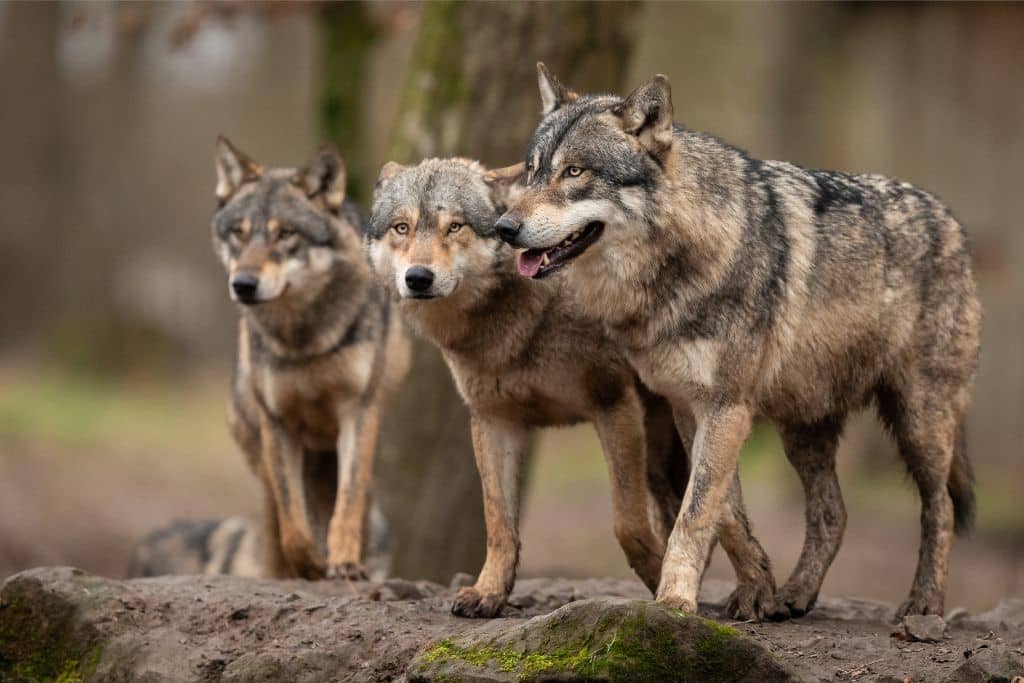Once systematically exterminated by US government-backed programmes, the grey wolf has received a second lease on life. Hunting laws still threaten the wolf’s survival in some states. In an exclusive interview with Earth.Org, Zee Soffron, Facility and Program Director of Wolf Hollow – a non-profit wolf sanctuary in Massachusetts, explains the ineffectiveness of lethal methods and how to achieve peaceful coexistence.
—
Wolves are a species indigenous to North America. They have lived in the region since the Pleistocene and are believed to have crossed the Bering Land Bridge from Asia. Before the arrival of Europeans in New England, North American indigenous peoples lived in harmony with wolves; some had even built a relationship with them. To this day, American Indian tribes fight to protect and preserve wolves through advocacy and restoration efforts.
As European settled in the continent in the 17th century, bringing livestock and horses for transportation, they made their first encounters with wolves, a docile animal that otherwise would have probably avoided contact with humans. Naturally, wolves began to hunt cattle and sheep brought from across the Atlantic. Farmers and landowners then resorted to baiting and trapping to protect their livelihoods, kickstarting a century-long extermination campaign.
Massachusetts was the first place in the so-called New World to institute official wolf-hunting programmes. In 1630, the Puritan settlers of the Massachusetts Bay Colony offered a bounty for dead wolves: exactly one schilling per wolf killed. Ten years later, the reward increased to forty schillings, a sizeable amount for that period. The intention was to encourage settlers to kill as many wolves as possible, and by 1840, the grey wolf was officially extinct in the state. There were between 250,000 and two million wolves in the contiguous United States upon European settlement. By the early 1900s, the grey wolf had almost entirely disappeared from the lower 48 states.
You might also like: Rewilding North America and the West
Legal Protection of the Grey Wolf: Two Steps Forward, One Step Back
The signing of the Endangered Species Act of 1973 into law represented a turning point for the fate of the grey wolf in North America. The Act facilitated the recovery and conservation of endangered and threatened species populations, minimizing the damage that federal and private actors can do to these species and their habitats. By 1978, the United States Fish and Wildlife Service (FWS) had finally listed the grey wolf as endangered throughout the contiguous states, except in Minnesota, where it was listed as threatened. After receiving federal protections, the population of grey wolves saw a tremendous recovery in the Western Great Lakes region.
There are currently no wolves in the Northeast of the United States. Some singular sightings have been registered; however, it is uncertain whether these wolves are establishing new territories or simply passing through. Alaska is home to approximately 8,000 to 11,000 grey wolves, while only 5,500 can be found in the 48 contiguous states. Grey wolves inhabit the Western Great Lakes states of Minnesota, Wisconsin, and Michigan, as well as the Northern Rockies states of Idaho, Montana, and Wyoming. In the last couple of years, more wolves have also been spotted in Eastern Washington, Oregon, Northern California, and Colorado.
After 45 years, the Trump administration removed the grey wolf’s endangered species protections, except for a small population of Mexican grey wolves in Arizona and New Mexico. The Endangered Species Act serves two functions: preventing extinction and helping dwindling populations recover so that the law’s protections are no longer needed.
According to David Bernhardt, former US Secretary of the Interior, the wolf species had at that time “exceeded all conservation goals for recovery.” Biologists and conservationists condemned the Trump administration’s short-sighted decision, clarifying that wolves are still functionally extinct throughout the vast majority of their historic habitat.
In 2022, a decision from US district judge Jeffrey White in Oakland, California, restored federal protections for grey wolves across much of the country. Yet, wolves in the northern Rocky Mountains and portions of several adjacent states remained under state jurisdiction. Wolf hunting is currently legal in Idaho, Montana, Wyoming, and Alaska, the last being the only state where the animal is not endangered. Wisconsin lost 14% of its wolf population in 2021, following nearly three days of slaughter. Wolf hunting season was supposed to last two weeks, during which 125 wolves were allotted to be harvested. Yet a total of 218 wolves died in just 60 hours. As of today, like most of the United States, citizens of Wisconsin can no longer participate in a wolf harvest season.
Misplaced Blame
“Wolves continue to be a very divisive animal,” explains Zee Soffron, Facility and Program Director of Wolf Hollow, a non-profit wolf sanctuary and educational facility in Ipswich, Massachusetts. Wolves are politicised and “attitudes towards them will break right down along party affiliation,” he continues.
According to Soffron, there is an urban-rural cultural divide over wolves and their protection; while urban voters are keen on protecting wolves, rural voters are more concerned about their livelihood being threatened by these predators.
“The ranching industry remains a big driver for wolf conflict,” explains Soffron. However, as government data shows, wolves have a negligible effect on the US cattle and sheep industries. Figures from 2015 show that 280,570 cattle were killed by predators in the United States, representing a mere 0.3% of the country’s cattle inventory. Wolves were only responsible for 0.009% of those deaths.
Instead, as reports from the US Department of Agriculture-Animal and Plant Health Inspection Service (USDA) demonstrate, the primary causes of cattle and sheep losses were health problems, weather, theft, and other maladies.
Nevertheless, the lethal management of wolves continues to be a common practice in Alaska, Idaho, Montana, and Wyoming. “There are different quotas based on tactics and methods,” explains Soffron.
In Montana, a person can kill up to 20 wolves annually with no more than ten via hunting and no more than ten via trapping. This season, the state will allow for the killing of 456 wolves, representing 40% of the total population.
According to Soffron, trapping is an especially cruel and inhumane activity. “It is a brutal way to go. Animals hurt themselves more trying to get out of the trap, even going to the length of chewing up their own leg,”
In addition to being an inhumane practice, it is neither particularly effective nor well-targeted. “70% of those traps are catching unintended targets,” he explains. “Pet dogs that wandered off trail often get caught. But owls and bald eagles have also been spotted flying around with traps attached to them.” All wildlife are possible victims of indiscriminate traps.
Recounting events from 2017, Soffron argues that lethal methods are counterproductive in protecting livestock from wolves. In eastern Washington, there was a wolf pack called the Profanity Peak wolf pack. Researchers told the local ranching community to keep their animals away from their area as wolves had puppies to feed. “Those alarms were ignored,” says Soffron. Some cattle encroached upon that area, driving away deer and natural prey the wolves would have been hunting. Eventually, wolves from the Profanity Peak pack killed some cattle, which turned into a hunting campaign. “The state of Washington spent over $135,000 over a few months to eradicate the entire pack, including 5 months of puppies, over a few cows,” Soffron recalls. Within a year or two, more wolves moved into that area as the environmental conditions had not changed and could still provide a good habitat for them.
When asked about the most efficient way to keep wolves from killing livestock, without hesitation, Soffron suggests good husbandry. Local governments should focus on helping ranchers and wolves coexist in the same territory, avoiding conflict and the lethal backlash that follows. Wolves are shy animals, easily scared. The use of non-lethal deterrents is an effective strategy to keep wolves off one’s property. Non-lethal methods include guard dogs, sound systems, electric fencing, spotlights, and fladry – a centuries-old, simple tool that consists of a perimeter of brightly colored flags.
The relationship between humans and wolves is influenced by deeply rooted, implicit beliefs that often clash with biologically based knowledge. Thankfully, public perceptions of wolves are starting to change.
At Wolf Hollow, Soffron asks visitors whether they believe wolves are dangerous. “30 years ago, 90% of people would respond that wolves are dangerous. Today it is closer to 10%.”
This societal change is sparked by organisations like this one that put a lot of effort into safeguarding wolves and their survival but also educating the public about this fascinating creature.
____
Wolf Hollow is a 501(c)3 non-profit. With only one full-time employee, the facility is staffed primarily by volunteers and supported solely by donations, adoptions, and proceeds from admission and gift shop sales. Wolf Hollow was founded by Paul C. Soffron in 1988. Feeling like the underdog of his family, he identified with wolves, an underappreciated and misunderstood animal. Following a near-death experience in his forties, he began contemplating his legacy, and the safeguarding of wolves became his life purpose. Inspired and supported by Wolf Park in Indiana, Wolf Hollow received its first wolf in 1990 and officially opened to the public. To this day, Paul’s original mission, “to preserve the wolf in the wild, through education and exposure,” remains the cornerstone of Wolf Hollow’s work.
For information on Wolf Hollow. visit www.wolfhollowipswich.org or email them at info@wolfhollowipswich.org.
You might also like: The Fall and Rise of the American Grey Wolf


















